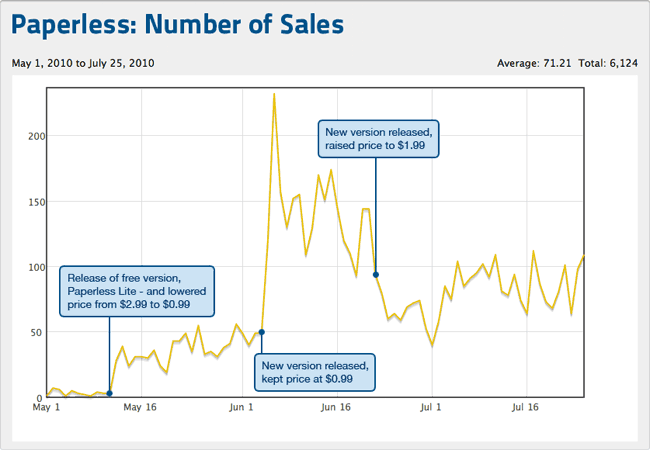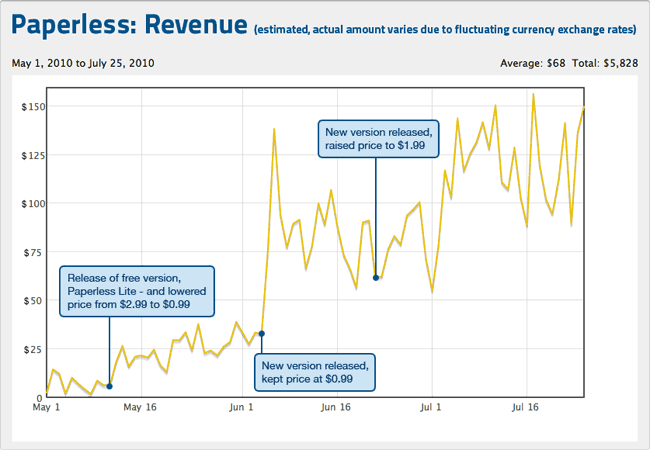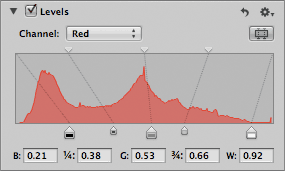NOTE: I originally posted this article as a guest author on Bob Walsh’s “47 Hats” website. I’m reposting it here for posterity.
In the article “How to be a successful iPhone developer“, Bob Walsh offered some thoughts on why apps succeed or fail. As a developer who has had an app in Apple’s app store for a few months now, I thought I’d add to the discussion with some hard data and thoughts on what I think I’ve done right, and what I could be doing better.
Ten months ago, I decided to learn to make an iPhone app because I wasn’t satisfied with any of the to do list and notes apps in the app store. All of the ones I tried were too complicated, or didn’t offer the features I wanted. So, I bought a couple of books and started learning objective-c and the iPhone programming API’s. It started off as an experiment, but I discovered that I really like developing software for the iOS platform.
In March I released my first app “Paperless“, which is used to make lists and checklists. My goal was to make it flexible and easy to use… something that just about anybody could find a use for. I’ll spare you the sales pitch though – if you want to find out more you can read about it on my website.
The first couple of months were slow in sales due to the fact that I didn’t have much time for marketing, but the people who did find it were generally very positive about it and provided good feedback. Over time I’ve made improvements based on that feedback, and my user base has grown steadily.
During May, I released “Paperless Lite”, a free version of the app to let people try it out before buying the full version. At the same time, I temporarily lowered the price of the full version to just $0.99 to generate more sales. Both of those things really helped, and after another small update 3 weeks later, I reached the number 3 spot in the Productivity category in the UK app store, and was doing okay in the U.S. app store as well.
User reviews have been overwhelmingly positive, and for most of July Paperless hovered around the #30 – #45 spot in the Productivity category in the U.S. At $1.99 per sale ($1.39 after Apple takes its 30 percent) that works out to around $100 – $150 a day. It’s not enough to meet my long term goal of being able to develop apps full time, but it’s a good start. A couple of Sundays ago, sales of my app brought in over $150 while I spent time with the family at the beach.
In the graphs below, you can see how offering the free version of Paperless helped to generate some sales – and how pricing adjustments have affected the number of sales and the income I’ve made. I can’t fully explain the first big spike on June 3rd. I released a new version then and that’s when it caught on in the UK. The popularity of it there only lasted a month, but luckily as sales in the UK dropped, sales in the U.S. picked up.
What I’m Doing Right
Some people have said that the app store is like the lottery. That, in order to do well, you have to get lucky with Apple featuring your app or placing you in their “New and Noteworthy” or “Staff Favorites” category. While that would certainly help (a lot) – it isn’t something I’m relying on. What I AM doing is:
Trying to make apps that are functional, easy to use, and look great… it’s the Apple way and it’s what customers expect. Some apps try to do too much, which leads to a complicated and cluttered user interface. With Paperless, I think I’ve done a pretty good job at keeping it simple and attractive, while offering a lot of functionality.
Enjoying what I do, and creating things out of the love for doing it – not out of trying to make a quick buck. I care more about my product and my users experiences with it, than I do about making money. I figure that if I have a good product that people really find useful – then the money will come.
Listening and responding to customers needs. I have a “Feedback” button in my app so that people can easily email me if they need help or want to offer suggestions. I’m open with customers, and am genuinely interested in knowing what they think could be done better in Paperless – and they appreciate that.
Constantly making improvements. I know that Paperless isn’t perfect, and there are a few key features (landscape mode!) that need to be added. I have an FAQ to let customers know what features I plan on adding in a future release – or at least offer some reasoning behind why a specific feature isn’t there.
Creating a recognizable brand for myself, that people trust. A few customers have said they can’t wait to see what I come up with next. So, once I do make another app, I know that I’ll have some interest in it from the beginning.
Always learning new things. I’m constantly reading Apple’s documentation, iOS development books and watching video tutorials to try and expand my knowledge.
What I Could Do Better
So, those are the things I think I’m doing right – but what about things I could do better, or that I’m not doing at all? There aren’t enough hours in each day to do everything I would like, and here are the big things I’ve neglected:
The Cloud. Users don’t like their data stuck on one device. They want to be able to view and edit their information on their computer as well as their phone and possibly their iPad. Not every app needs this, but for something like Paperless the ability to sync and share information would be very useful. I’d love to build a web service that synced with Paperless, along with a Mac OS X app and an iPad version – but, as a one person shop doing this in my spare time, those things are going to take a while.
Localization. While my app is available for purchase in any of the Apple app store regions, I haven’t taken the time (or spent the money) to have features within the app translated to other languages. Translating it to the biggest 3 or 4 non-English speaking markets could potentially double my income.
Marketing. If I’m not relying on a featured spot by Apple, then the only way I’m going to gain more customers is by reaching out in other ways. I need to spend a lot more time letting people know about my app, and in a way that sets it apart from the hundreds of other list/todo/notes apps in the app store. With so many other developers vying for attention, it’s hard to get coverage for your app on many of the app review sites or tech related news sites. I’m going to have to find ways to reach outside of the online Apple community.
In Steve Jobs’ presentation on iOS4 in April, he stated that over 50 million iPhones had been sold. If you add the number of iPod Touches to that, it’s over 85 million. The 3 million iPads and 1.7 million iPhone 4’s bring the total of iOS devices out there to around 90 million. That’s a huge market, even if you consider that some people own more than one device.
If I sold Paperless at the current price of $1.99 to be installed on just one half of one percent of those devices, I’d make roughly $600,000 (before taxes).
Surely there must be a way? I’m working towards that, and feeling optimistic…









